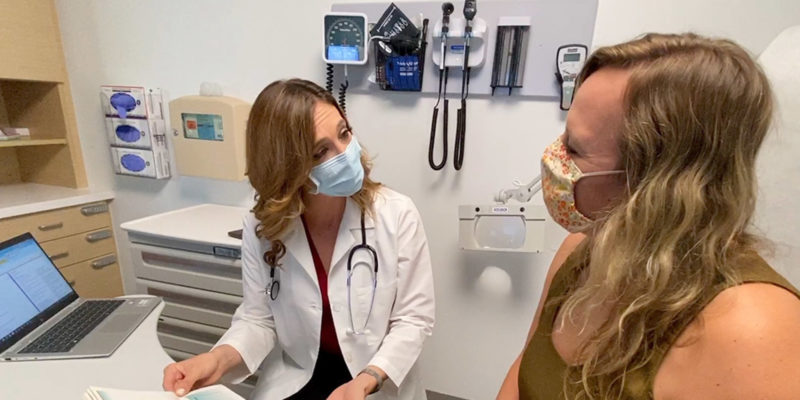
Integrated Care Stories
An overview of our integrated care model
Kaiser Permanente achieves better outcomes through a combination of care coordination, comprehensive data collection and use, and aligned incentives that all promote affordable, high-quality care. This case study, part of our Integrated Care Stories series, highlights the benefits of Kaiser Permanente’s approach.
The challenge
Disconnected clinical practices: The prevailing U.S. health care system relies heavily on disconnected clinical practices, producing fragmented patient care. Many Americans must knit together a network of health professionals who practice independently, share no real connections to one another, and rarely share information or work closely with other practices.
Fee for service: The predominant payment system is fee-for-service, with insurers paying clinical practices for specific services they provide. This results in inefficient and confusing coverage for patients. Often, patients are billed for every discrete service they receive. They must track their bills and wait to get reimbursed by the health insurer for their expenses, and the insurer and their physician may disagree about needed services. Once individuals are paid, they must review what costs remain, and either resubmit bills or pay for any unreimbursed expenses.
Quantity over quality: Fee-for-service approaches also lead to a focus on quantity of services, rather than on high-quality care. When health care professionals are paid based on number and intensity of services they deliver, this drives the delivery of more care and more services, regardless of whether they are necessary or beneficial. Unnecessary care can be wasteful or sometimes even harmful.
Challenges for health care professionals: When clinicians have limited connections to other clinicians, they have limited information about the full range of their patients’ medical diagnoses, tests, and treatments from other clinicians or hospitals. They also must deal with multiple payers, and different payers’ varying requirements, to manage their practices.
Population health challenges: The fee-for-service model encourages a focus on managing acute costs rather than investing in long-term population and community health. Health professionals in the prevailing system cannot easily monitor care across patients to ensure care is meeting quality guidelines, and cannot use aggregate data to identify opportunities for improvement.
The Kaiser Permanente approach: integration and coordination
Kaiser Permanente’s approach to financing and organizing care delivery is different and results in high-quality care and services, and excellent member and population health outcomes.
Kaiser Permanente’s mission is to provide high-quality, affordable health care services and to improve the health of our members and the communities we serve. In each of our markets, Kaiser Permanente provides care to members and delivers value to communities through distinct but interconnected entities. The nonprofit Kaiser Foundation Health Plan, or KFHP, handles health coverage, enrolling groups and members, contracting with medical group partners, managing medical facilities and hospitals owned by Kaiser Foundation Hospitals, tracking and managing financial risk, providing administrative services, and owning and operating complementary services like pharmacies, labs, and information technology.
The nonprofit Kaiser Foundation Hospitals, or KFH, owns hospitals and medical facilities, and contracts with independent hospitals. The Permanente Medical Groups, or PMGs, are self-governed, multispecialty medical groups — one in each region served by Kaiser Permanente — that contract exclusively with KFHP to provide care for Kaiser Permanente members, providing and overseeing clinical care, hiring and managing clinical staff, and managing quality improvement and appropriate resource utilization.
As a committed community partner, Kaiser Permanente invests in improving community conditions that impact the health of our members and the communities we serve, both now and in the long-term. For example, Kaiser Permanente connects people to food assistance and other needed services, invests in affordable housing, supports efforts to address racial inequities, and promotes expanded economic opportunity.
Coordinated, high-quality care
As the health plan, medical groups, and hospitals work together, they share a deep and ongoing commitment to eliminate barriers, collaborate effectively, and simplify access to services and care. This structural and functional integration benefits our members and communities.
Connected, coordinated care teams
Members benefit from well-coordinated care in the Kaiser Permanente system. Clinicians can easily coordinate with one another and seamlessly refer patients to other team members — primary care doctors, specialists, lab technicians, pharmacists, and other health care professionals.
Convenient care
Physician offices, labs, hospitals, and pharmacies are often colocated, providing members with quick and easy access. In general, members do not need to track and submit medical bills.* If our members are traveling and need urgent or emergency care outside the Kaiser Permanente network, we help them access that care.
High-quality care with clinical decisions made by doctors and patients
Physicians work with their patients to develop personalized care plans, making decisions about medical care together. To inform those decisions, doctors use the best available evidence and create clinical practice guidelines. They champion quality improvement, ensuring that our care teams practice medicine based on the best, most up-to-date information, incorporating innovative approaches.
Comprehensive data that improves care
Kaiser Permanente manages a highly connected data system that captures comprehensive data and provides that information to clinicians, care teams, and members. This enables timely and well-informed care delivery, supports quality improvement, and drives clinical and health services research, positioning Kaiser Permanente to improve health outcomes. Kaiser Permanente learns from our clinical practice and we also practice evidence-based medicine, implementing what we learn from our experiences and other medical research.
Integrated data for each member
Members can easily access their personal data through Kaiser Permanente’s comprehensive, interconnected data system. They can see detailed health information, connect with their care team, and access telehealth services through kp.org, our secure, web-based member portal.
Information sharing across clinical care teams
Clinicians have access to all Kaiser Permanente medical data for every member, enabling care teams to identify opportunities to improve the safety and quality of care. Kaiser Permanente tracks and maintains records over decades, enabling a long-term perspective on each individual’s health over time. Care teams can make well-informed decisions based on a full range of patient information and can easily connect with each other to work effectively as a team.
Extensive population-level data
With access to data across large numbers of patients over long periods of time, Kaiser Permanente tracks population health trends, and identifies and pursues opportunities to improve and to eliminate disparities in care. Our extensive database and our research capacities allow us to serve as a helpful clinical and health services research partner to national agencies and academic institutions.
Research and quality improvement
We analyze care management processes and outcomes and use the results to continuously improve. We then share findings from this practice-based clinical research to benefit others beyond Kaiser Permanente. Our care teams also can access a constantly updated clinical library, helping us stay abreast of additional new evidence-based approaches.
Aligned incentives
Under our financial model, we receive a prepayment for each member and then are responsible for their health care. This incentivizes helping our members improve their health and stay healthy — supporting a focus on prevention, health promotion, health maintenance, and effective management of both acute and chronic conditions.
Flexibility within a budget
The Kaiser Foundation Health Plan collects member premiums in advance and then pays delivery system partners for members’ care throughout the year. This creates the flexibility within and across the health plan, the hospitals, and the medical groups to deploy those resources to best meet our members’ needs and encourages wise use of resources. Instead of relying on revenues generated when patients are sick, we are incentivized to invest in longer-term infrastructure and population health investments that improve long-term outcomes, and to provide timely, effective, and efficient care and service that allow us to retain and expand our membership.
Aligned planning and budgeting
Across the health plan, the medical groups, and the hospitals, leaders work together as they develop budgets for services and facilities. This promotes attention to quality improvement and operating efficiencies. Resource stewardship is seen as everyone’s responsibility. Premium dollars should be spent in ways that maximize health value, with a focus on care, interventions, and activities that lead to better health outcomes.
Aligned clinical incentives
Physicians are salaried. As a result, they can focus on providing the highest quality care rather than spending time on billing and identifying ways to meet revenue targets. Physicians do not have fee-for-service incentives to provide unnecessary care. They also do not benefit from withholding needed care that supports member health, a result of guardrails and accountabilities that measure and ensure high-quality care. The medical groups invest in primary care and ensure the right number of specialists and subspecialists. This approach to compensation, along with Kaiser Permanente’s overall mission, makes it easy to attract and retain highly sought-after physicians and other health care personnel.
Focus on individual and population health
Our mission, and our long-term perspective — free from investors’ focus on short-term returns — motivates us to address individual and community drivers of health. We analyze member health trends to identify opportunities for improvement and support quality improvement and prevention. Across these areas, we work to eliminate racial and economic disparities, make community investments, and collaborate with community partners. These investments in individual and population health help us retain our members, and Kaiser Permanente benefits when those long-tenured members and the broader communities we serve realize positive health outcomes.
*Kaiser Permanente offers high-deductible plans, but this represents a small percentage of total membership.
Kaiser Permanente’s integrated care and coverage model differs from much of the United States health care system, which relies on disconnected clinical practices paid through fee-for-service. These disconnected approaches typically result in highly fragmented care, a focus on quantity of services rather than high-quality care, and an emphasis on acute care rather than long-term investments in population and community health.
Kaiser Permanente achieves better outcomes through a combination of care coordination, comprehensive data collection and use, and aligned incentives that all promote affordable, high-quality care. This case study, part of our Integrated Care Stories series, highlights the benefits of Kaiser Permanente’s approach.










